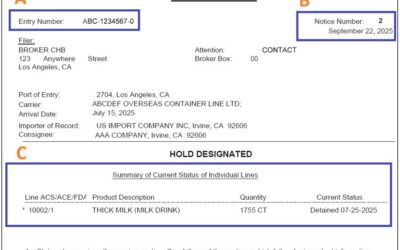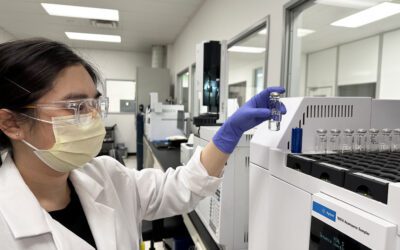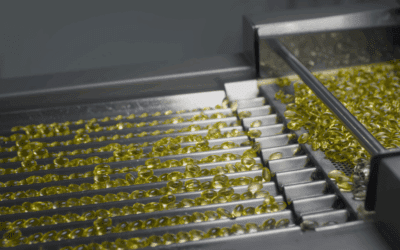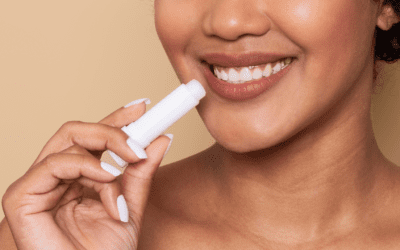Certified Laboratories Blog
Insights for the food & beverage, cosmetics, OTC, supplements, and other industries.
How Cosmetics Microbiology Testing Supports Product Safety and Quality
Reviewed and Approved by Richard A. Boehler, Jr., MSc., Cosmetic Microbiology Laboratory Manager, Certified Laboratories 1-Minute Summary Cosmetics microbiology testing verifies that products are free of harmful microbes and safe for consumer use. ...
How to Read an FDA Notice of Action (NOA)
Reviewed and Approved by Tim Lombardo, Sr. Dir. of Food Consulting Services, EAS Consulting Group; Annie Hughes, Director, General Manager FDA Detention, Certified Laboratories FDA detentions are on the rise. In 2025 alone, the Agency reviewed nearly 50 million...
Ido-BR1 Testing for Dietary Supplements: New Validated Method
Reviewed and Approved by Matt Traynor, PhD, Vice President, Innovation and Validation, Certified Laboratories 1-Minute Summary Ido-BR1 has shown promise in clinical trials as an anti-inflammatory for joint health, making it a popular ingredient in...
Health Canada’s NHP GMPs 4.0: Stability Testing FAQs
Reviewed and Approved by Matilda Baghdasarian, Laboratory Services Associate Director 1-Minute Summary Health Canada’s NHP GMPs Version 4.0 takes effect March 4, 2026, replacing the 2015 guide. Every natural health product (NHP) must now have a...
Want Accurate Results, Faster? Send Your COA with Your Sample
Reviewed and Approved by Matt Traynor, PhD, Vice President, Innovation and Validation, Certified Laboratories 1-Minute Summary COAs provide key technical details that are often absent from the sample submission form. They help us choose the most...
Bemotrizinol in the U.S. – Why SPF Product Manufacturers Should Prepare Now
Reviewed and Approved by Matt Traynor, PhD, Vice President, Innovation and Validation, Certified Laboratories 1-Minute Summary Bemotrizinol is under FDA review, with a potential approval decision expected by March 2026. Globally used in sunscreens,...
Dietary Supplement Component Specifications & Testing Explained
Reviewed and Approved by Shelly Blackwell, Sr. Dir. Dietary Supplements & Tobacco Consulting, EAS Consulting Group 1-Minute Summary The FDA continues to cite failure to verify component specifications as a top observation during inspections. ...
Cosmetic Manufacturers Must Prepare for Proposed Ingredient Bans
Reviewed and Approved by Rasha Abueid, R&D Supervisor, Certified Laboratories 1-Minute Summary Pending U.S. federal legislation could ban 18 ingredients and ingredient classes used in cosmetics. The Toxic-Free Beauty Act headlines the bills and would...
Phil Gillespie Named Chief Financial Officer of Certified Group
New CFO to Support Company’s Growth and TIC Market Expansion SAN ANTONIO, Texas – Sept. 8, 2025 – Certified Group today announced the appointment of Phil Gillespie as Chief Financial Officer (CFO). With more than 30 years of experience in corporate finance, Mr....
Why You Must Verify the Active Vitamin C in Your Cosmetic Products
Reviewed and Approved by Matt Traynor, PhD, Vice President, Innovation and Validation, Certified Laboratories 1-Minute Summary Vitamin C is a popular but unstable compound in skincare, requiring accurate content verification to support label claims. In the...
Measurement Uncertainty (MoU) – Why the ± Matters in Analytical Chemistry
Reviewed and Approved by Matt Traynor, PhD, Vice President, Innovation and Validation, Certified Laboratories 1-Minute Summary Measurement Uncertainty (MoU) explains why lab results are reported with a ± range — it's a built-in measure of scientific...
1,4-Dioxane Testing for Cosmetics and Personal Care Products – 0.5 PPM LOD
Reviewed and Approved by Matt Traynor, PhD, Vice President, Innovation and Validation, Certified Laboratories 1-Minute Summary New York state enforces a 1,4-dioxane limit of 10 ppm in cosmetics and 1 ppm in personal care products. USP <467> and...
Detailing the Top Five 21 CFR 111 Compliance Issues for Supplement Manufacturers
Reviewed and Approved by Shelly Blackwell, Senior Director, Dietary Supplement and Tobacco, EAS Consulting Group 1-Minute Summary The FDA’s most common 21 CFR 111 compliance observations involve missing component and finished product specifications, as...
State Legislation for Heavy Metals in Cosmetics [2025]
Reviewed and Approved by Maged Sharaf, Ph.D., Senior Director, Labeling, Cannabis and Claims Consulting Services, EAS Consulting Group 1-Minute Summary There are no U.S. Federal regulations that establish specific limits for heavy metals like lead or...
Understanding Photostability Testing for Cosmetic & OTC Drug Products
Reviewed and Approved by Matilda Baghdasarian, MBA, Associate Director/Safety Officer, Certified Laboratories 1-Minute Summary Photostability testing simulates long-term light exposure to ensure OTC drug products and cosmetics remain safe and effective...
Certified Group at ASTA 2025 Annual Meeting and Exhibits: Ensuring Safety, Quality, & Innovation of Spices
By Jay Alappat, Ph.D, Chief Science Officer – Chemistry, Certified Group The global spice industry continues to grow, driven by increasing consumer demand for bold flavors, clean labels, and high-quality ingredients. However, with this growth comes the...
Tips for Auditing a Contract Lab for Testing Supplements
Reviewed and Approved by Shelly Blackwell, Senior Director, Dietary Supplements and Tobacco, EAS Consulting Group, a Certified Group company 1-Minute Summary Manufacturers should audit a contract lab’s personnel, test methods, equipment, and quality...
How to Substantiate Dietary Supplement Label Claims
Reviewed and Approved by Paula Brock, Ph.D., MSCI, Independent Senior Regulatory & Scientific Consultant, EAS Consulting Group, a Certified Group company 1-Minute Summary Substantiating dietary supplement label claims requires competent, reliable...
How to Test Products Containing Petrolatum
Reviewed and Approved by Matt Traynor, PhD, Innovation and Validation Director, Certified Laboratories Several cosmetic and over-the-counter (OTC) drug products are formulated with petrolatum due to its emollient, protective, and water-resistant properties....
Types of Non-Thermal Process Validation
Non-thermal process validation encompasses a variety of innovative techniques designed to enhance food safety and extend shelf life without relying on traditional heat-based methods. These advanced technologies, ranging from pulsed electric fields to high hydrostatic...














![State Legislation for Heavy Metals in Cosmetics [2025]](https://certified-laboratories.com/wp-content/uploads/cosmetics-in-pink-bag_572508496-400x250.png)





